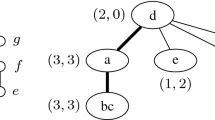Abstract
In this paper we consider the disjoint paths problem. Given a graphG and a subsetS of the edge-set ofG the problem is to decide whether there exists a family ℱ of disjoint circuits inG each containing exactly one edge ofS such that every edge inS belongs to a circuit inC. By a well-known theorem of P. Seymour the edge-disjoint paths problem is polynomially solvable for Eulerian planar graphsG. We show that (assumingP≠NP) one can drop neither planarity nor the Eulerian condition onG without losing polynomial time solvability. We prove theNP-completeness of the planar edge-disjoint paths problem by showing theNP-completeness of the vertex disjoint paths problem for planar graphs with maximum vertex-degree three. This disproves (assumingP≠NP) a conjecture of A. Schrijver concerning the existence of a polynomial time algorithm for the planar vertex-disjoint paths problem. Furthermore we present a counterexample to a conjecture of A. Frank. This conjecture would have implied a polynomial algorithm for the planar edge-disjoint paths problem. Moreover we derive a complete characterization of all minorclosed classes of graphs for which the disjoint paths problem is polynomially solvable. Finally we show theNP-completeness of the half-integral relaxation of the edge-disjoint paths problem. This implies an answer to the long-standing question whether the edge-disjoint paths problem is polynomially solvable for Eulerian graphs.
Similar content being viewed by others
References
Lichtenstein, D.: Planar formulae and their uses,SIAM J. Comput. 11 (1982), 329–343.
Lomonosov, M. V.: Combinatorial approaches to multiflow problems,Discrete Applied Mathematics 11 (1985), 1–93.
Matoušek, J., Thomas, R.: On the complexity of finding iso- and other morphisms for partialk-trees, In preparation (manuscript May 1988).
Middendorf, M., Pfeiffer, F.: Edge disjoint paths in graphs with bounded tree-whidth, In preparation.
Robertson, N., Seymour, P. D.: Graph minors V. Excluding a planar graph,J. Combinatorial Theory (Ser. B),36 (1984), 49–64.
Schrijver, A.: Homotopic Routing Methods, in:Paths, Flows and VLSI Layout. (Korte, B., Lovász, L., Prömel, H.-J., Schrijver, A. eds.) Springer 1990.
Sebő, A.: Dual Integrality and Multicommodity Flows, in: Colloquia Mathematica Societatis János Bolyai,52.Combinatorics, (eds.: A. Hajnal, L. Lovász and V. T. Sós).
Sebő, A.: Integer plane multicommodity flows with a bounded number of demands, Technical Report, Bonn, 1988, 88534-OR.
Seymour, P. D.: On odd cuts and plane multicommodity flows,Proc. London Math. Soc. (3)42 (1981), 178–192.
Seymour, P. D.: Matroids and multicommodity flows,Europ. J. Combinatorics 2 (1981), 257–290.
Author information
Authors and Affiliations
Additional information
Supported by Sonderforschungsbereich 303 (DFG)




